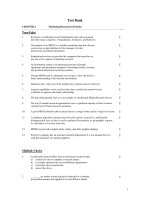Lecture Marketing research (12th edition) - Chapter 23: Marketing-mix measures
Bạn đang xem bản rút gọn của tài liệu. Xem và tải ngay bản đầy đủ của tài liệu tại đây (749.37 KB, 33 trang )
1
Marketing Research
Aaker, Kumar, Leone and Day
Twelfth Edition
Instructor’s Presentation Slides
2
Chapter TwentyThree
Marketing-Mix Measures
Marketing Research 12th Edition
3
Phases in New Product Research
Concept Generation
Need Identification
Concept Identification
Concept Evaluation and Development
Product Evaluation and Development
Testing the Marketing Program
Marketing Research 12th Edition
4
Concept Generation
Need Identification
Perceptual maps
Social and environmental trends
Benefit structure analysis
Product users
Focus-group interviews
Lead user analysis
Marketing Research 12th Edition
5
Concept Generation (Contd.)
Concept Identification
Are there any major flaws in the concept?
What consumer segments might be attracted to it?
Is there enough interest to warrant developing it further?
How might it be altered or developed further?
How are the concepts exposed?
To whom are the concepts exposed?
To what are they compared?
What questions are asked?
Marketing Research 12th Edition
6
Product Evaluation And Development
• Use Testing
▫ Virtual Product Testing
▫ Blind use test
• Predicting Trial Purchase
• Pretest Marketing
Marketing Research 12th Edition
7
Pretest Marketing Example
The ASSESSOR Laboratory Test Market Research Design and Measurement
Marketing Research 12th Edition
8
Test Marketing
• Sellin test markets
• Controlled Distribution Scanner Markets (CDSM)
Selecting the test cities
▫ Representativeness
▫ Data availability
▫ Media isolation and costs
▫ Product flow
Marketing Research 12th Edition
9
Really New Products
• Create or expand a new category, thereby making crosscategory
competition the key (e.g., fruit teas versus soft drinks)
• Are new to customers, for whom substantial learning is often required
(i.e., what it can be used for, what it competes with, why it is useful)
• Raise broad issues such as appropriate channels of distribution and
organizational responsibility
• Create (sometimes) a need for infrastructure, software, and addons
Marketing Research 12th Edition
10
Pricing Research
• Gabor and Grainger method
• Multibrand choice method
• Research for Profitoriented Pricing
• Research for Shareoriented Pricing
Marketing Research 12th Edition
11
Pricing Research (Contd.)
• The pricing pattern that is adopted for increasing market share is to:
▫ Offer a lower price (even below cost) when entering the market.
▫ Hold that price constant until unit costs produce a desired percentage
markup.
▫ Reduce price as costs fall to maintain markup at the same desired
percentage of costs.
• The types of information required for this pricing method are
▫ The nature of the experience curve.
▫ Breakeven points.
▫ Cost of units sold to additional market segments.
▫ Competitor costs.
▫ Forecast of the ‘‘decline’’ stage of the product life cycle.
Marketing Research 12th Edition
12
Distribution Research
Warehouse and Retail Location Research
• Centerofgravity Simulation
• Computerized Simulation Models
• Catchment Area Analysis
• Outlet Location Research
Center-of-gravity warehouse
location to serve five retail
stores.
Marketing Research 12th Edition
13
Distribution Research (Contd.)
Number and Location of Sales Representatives
• Sales effort approach
• Statistical analysis of sales data
• Field experiments
• Computerized models of sales force size and allocation by market
and by product line
Marketing Research 12th Edition
14
Advertising Research
Criteria
• Recognition
• Recall
▫ DayAfter Recall (DAR) measure – onair test
• Persuasion
▫ Forced exposure, brand preference change test
▫ Clutter/awareness score
▫ Attitudeshift measure
• Impact on purchase behavior
Marketing Research 12th Edition
15
Advertising Research (Contd.)
• Sample diagnostic questions:
▫Comprehension of message or slogan
▫Communication of secondary copy ideas
▫Evaluation of demonstrations, spokesperson, message
▫Perception of brand uniqueness or brand differentiation
▫Irritating or confusing elements
▫Viewer involvement
Marketing Research 12th Edition
16
Advertising Research (Contd.)
Purchase Behavior
• Coupon stimulated purchasing
• Splitcable tests
Copy Test Validity
• Qualitative Research
• Audience Impressions of the Ad
• Adjective Checklist
• Eye Movement
• Physiological Measurement
Marketing Research 12th Edition
17
Advertising Research (Contd.)
Media Research
• Measuring print vehicle audiences
▫Recentreading method
▫Readinghabit method
• Measuring broadcast vehicles audiences
Marketing Research 12th Edition
18
Sales Promotion Research
Promotional Tools
• Price Discounts
• Features
• Displays
• Coupons / Rebates
• Sweepstakes
Marketing Research 12th Edition
19
Sales Promotion Research (Contd.)
Promotional Strategy
• Hilo
• Every Day Low Price (EDLP)
A schematic framework of the major types of sales promotion.
Marketing Research 12th Edition
20
Sales Promotion Research (Contd.)
Specific Sales Promotional
Tools
Marketing Research 12th Edition
21
TQM – Total Quality Measurement
• TQM is a process of managing complex changes in the
organization with the aim of improving quality
• Is a business philosophy that was used by the Japanese to
gain competitive advantage.
▫Now being discovered and used by American
organizations.
TQM can be defined as a systematic effort at continuous quality
improvement of all processes, products, services, and human
resources throughout the organization, undertaken with an objective
of improving customer satisfaction.
Marketing Research 12th Edition
22
TQM – Total Quality Measurement (Contd.)
The process of managing complex change and the effects when one of the links
in the chain is missing are depicted in the figure above
Marketing Research 12th Edition
23
TQM – Total Quality Measurement (Contd.)
• Characteristics of an organization that has implemented
TQM are:
●Continuous training and education of everyone in the
organization
●Establishment of quantifiable measures of progress
●Formation of cross functional teams that are
empowered and motivated
●Use of formal tools, techniques to maintain quality
Marketing Research 12th Edition
24
Total Quality Management (Contd.)
Information Requirements
• Measurement must be specific
• Track the correct measure
• Measure the outputs of the highest value to the customer
• Measure process and results
• Anticipate future customer and process requirements
Marketing Research 12th Edition
25
Total Quality Management (Contd.)
Analysis of Data in a TQM Company
• Who performs the analysis?
• What analytical techniques are used?
• Which data are analyzed and at what level of detail?
• How are data aggregated, and how are relations between data groups
crossreferenced?
• How does the company improve its analytical capabilities?
Marketing Research 12th Edition









